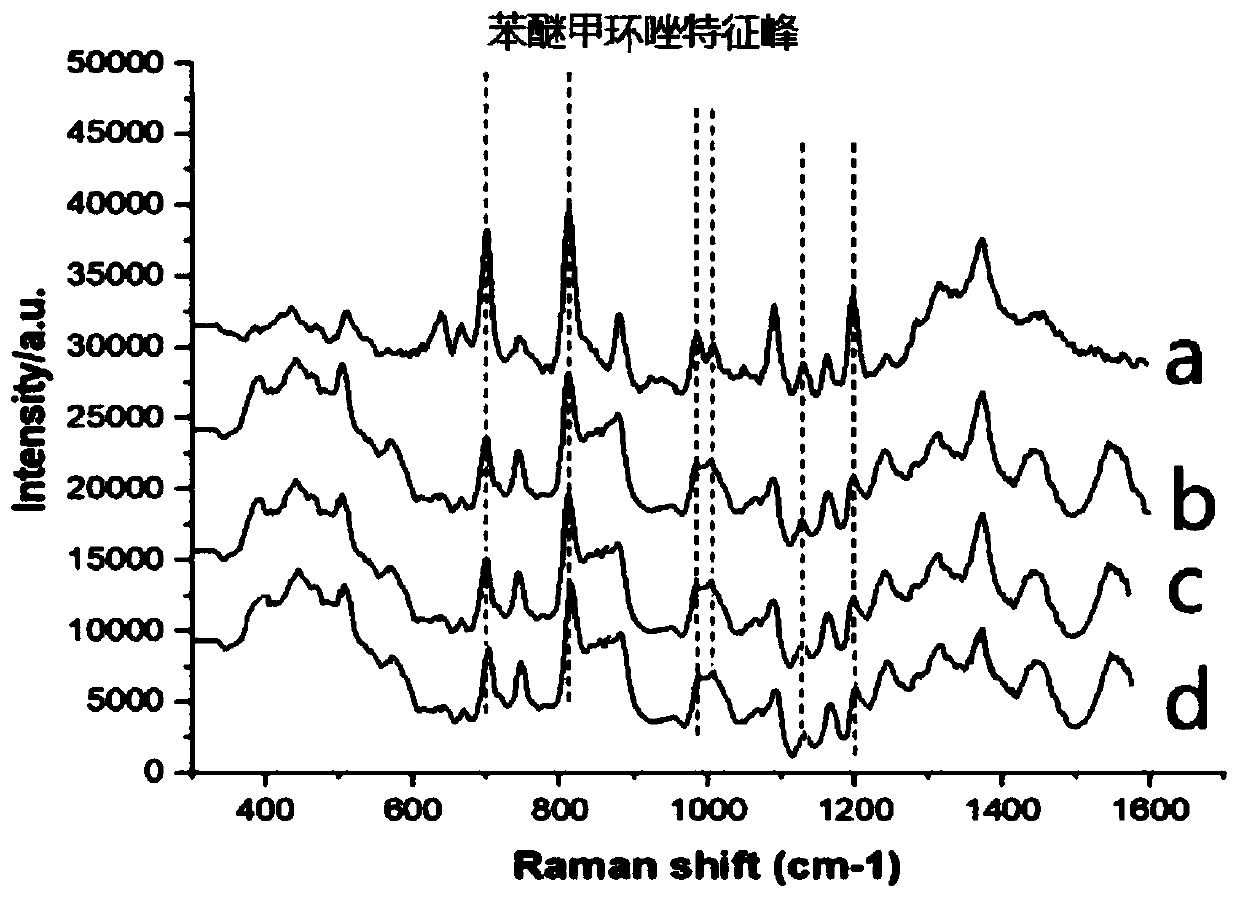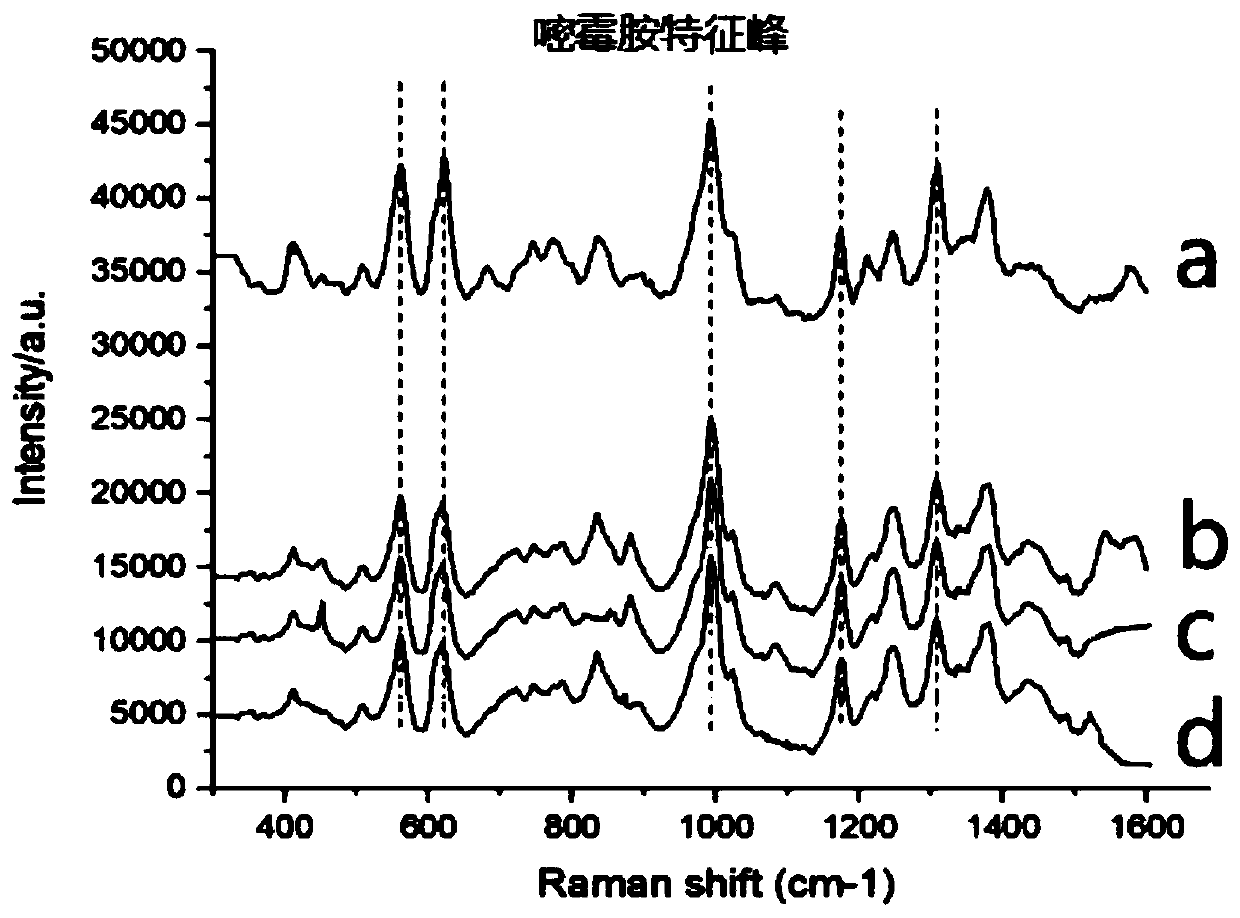Method of detecting bactericide residues in food through Raman enhanced spectrum
A technology of enhanced spectrum and fungicides, applied in the field of fungicide detection, can solve the problems of cumbersome processing procedures and long detection cycles, and achieve the effect of simple pre-processing procedures and wide application space
- Summary
- Abstract
- Description
- Claims
- Application Information
AI Technical Summary
Problems solved by technology
Method used
Image
Examples
Embodiment 1
[0037] Embodiment 1: Raman detection method of difenoconazole in rapeseed
[0038] Step 1, sample pretreatment: take 3 parts of rapeseed, add 0.01mg / kg, 0.03mg / kg and 0.05mg / kg of difenoconazole respectively, take 1g of chopped rapeseed and put it in a beaker, add 5mL Acetonitrile extraction, cover the lid for ultrasonic extraction for 5min. Take 3ml of the extract after ultrasonic extraction in a sample tube, add 3ml of acetone for extraction, shake for 10s, let it stand for stratification, then take 2ml of the extracted upper layer after stratification into a reagent bottle, add sodium sulfate for moisture absorption, shake 10s, let it stand for layering.
[0039] Step 2, prepare the sample solution to be tested: take 1ml of the supernatant in a volatilization bottle, put it in the volatilization pool until it evaporates to dryness, then take 400ul of acetonitrile in the volatilization bottle, shake for 10s, and obtain the sample solution to be tested.
[0040] Step 3, prepa...
Embodiment 2
[0044] Embodiment 2: the Raman detection method of tebuconazole in tomato
[0045] Step 1, sample pretreatment: take 3 parts of tomatoes, spike with 0.01mg / kg, 0.03mg / kg and 0.05mg / kg of tebuconazole respectively, take 1g of shredded tomatoes and put them in a beaker, add 5mL of acetonitrile to extract , cover the lid and conduct ultrasonic extraction for 5 min. Take 3ml of the extract after ultrasonic extraction in a sample tube, add 3ml of acetone for extraction, shake for 20s, let it stand for stratification, then take 2ml of the extracted upper layer after stratification into a reagent bottle, add sodium sulfate for moisture absorption, shake 10s, let it stand for layering.
[0046] Step 2, prepare the sample solution to be tested: take 1ml of the supernatant in a volatilization bottle, put it in the volatilization pool until it evaporates to dryness, then take 400ul of acetonitrile in the volatilization bottle, shake for 20s, and obtain the sample solution to be tested. ...
Embodiment 3
[0051] Embodiment 3: the Raman detection method of pyrimethanil in cucumber
[0052] Step 1, sample pretreatment: take 3 parts of cucumber, spike with 0.01mg / kg, 0.02mg / kg and 0.03mg / kg of pyrimethanil respectively, take 1g of chopped cucumber and put it in a beaker, add 5mL of acetonitrile to extract , cover the lid and conduct ultrasonic extraction for 5 min. Take 3ml of the extract after ultrasonic extraction in a sample tube, add 3ml of acetone for extraction, shake for 15s, let it stand for stratification, then take 2ml of the extracted upper layer after stratification into a reagent bottle, add sodium sulfate for moisture absorption, shake 10s, let it stand for layering.
[0053] Step 2, prepare the sample solution to be tested: take 1ml of the supernatant in a volatilization bottle, put it in a volatilization pool until it evaporates to dryness, then take 400ul of acetonitrile in the volatilization bottle, shake for 15s, and obtain the sample solution to be tested.
...
PUM
 Login to View More
Login to View More Abstract
Description
Claims
Application Information
 Login to View More
Login to View More - R&D
- Intellectual Property
- Life Sciences
- Materials
- Tech Scout
- Unparalleled Data Quality
- Higher Quality Content
- 60% Fewer Hallucinations
Browse by: Latest US Patents, China's latest patents, Technical Efficacy Thesaurus, Application Domain, Technology Topic, Popular Technical Reports.
© 2025 PatSnap. All rights reserved.Legal|Privacy policy|Modern Slavery Act Transparency Statement|Sitemap|About US| Contact US: help@patsnap.com



